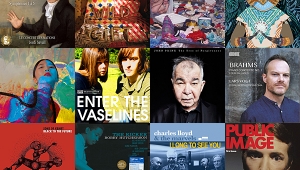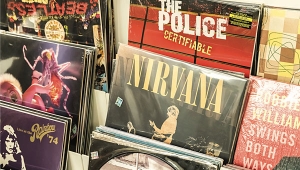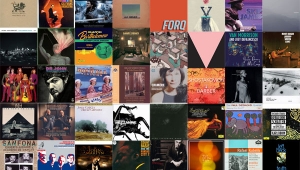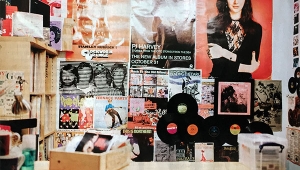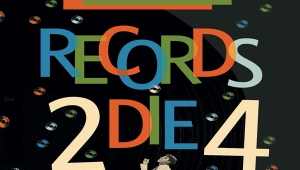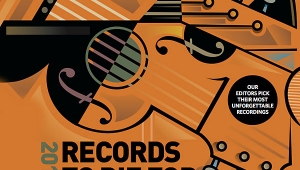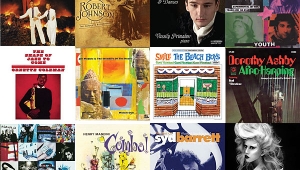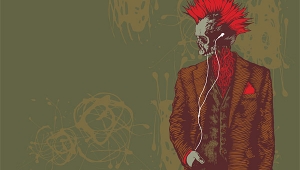| Columns Retired Columns & Blogs |
2006 Records To Die For Page 5
KEN KESSLER
KEB' MO': Peace... Back By Popular Demand
Okeh/Epic EK 92687 (CD). 2004. Keb' Mo', prod.; Mark Johnson, eng.; Stephen Marsh, mastering. DDD. TT: 39:47
DAVID JOHANSEN AND THE HARRY SMITHS: Shaker
Chesky JD236 (CD). 2001. David Chesky, Brian Koonin, prods.; Barry Wolifson, eng.; Nicholas Prout, editing, mastering. DDD. TT: 54:02
JOHN SIMON: John Simon's Album
water 145 (CD). 1970/2005. John Simon, orig. prod.; many orig. engs.; Pat Thomas, reissue prod.; Gary Hobish, remastering. AAD. TT: 39:37
VIVALDI: Bajazet
Ildebrando d'Arcangelo, Bajazet; David Daniels, Tamerlano; Patrizia Ciofi, Idaspe; Viveca Genaux, Irene; Marijana Mijanovic, Asteria; Elina Garanca, Andronico; Europa Galante, Fabio Bondi
Virgin 5 45676 2 (2 CDs, 1 DVD). 2005. Nicolas Bartholomée, prod.; Frédéric Briant, eng. DDD. TT: 2:26:26
THE COMPLETE NORMAN GRANZ JAM SESSIONS
Count Basie, Louie Bellson, Ray Brown, Benny Carter, Buddy DeFranco, Stan Getz, Dizzy Gillespie, Wardell Gray, Lionel Hampton, J.C. Heard, Johnny Hodges, Illinois Jacquet, Barney Kessel, Charlie Parker, Oscar Peterson, Flip Phillips, Buddy Rich, Charlie Shavers, Willie Smith, Ben Webster
Verve B0003252-02 QS01 (5 mono CDs). 1952–54/2000. Norman Granz, prod.; various uncredited engs.; Bob Irwin, Jayme Pieruzzi, Kip Smith, remastering. A?D. TT: 4:51:25
KEB' MO': Peace... Back By Popular Demand
Okeh/Epic EK 92687 (CD). 2004. Keb' Mo', prod.; Mark Johnson, eng.; Stephen Marsh, mastering. DDD. TT: 39:47
This 2004 release is a perfect example of familiarity breeding ennui, if not quite contempt: it was ignored. As in every other one of Keb' Mo's albums, the sound is delicious: rich, rolling, natural, with the kind of authentic twang that sends chills up and down spines. But this time, instead of reverential blues updates, the fiftysomething singer covered the great peace'n'love songs of the hippie era. Opening with Buffalo Springfield's "For What It's Worth" and ending with "Imagine," in between touching on Nick Lowe, the Rascals, the Youngbloods, and others, it will warm you like chicken soup. Even an NRA member will get a lump in the throat with Keb' Mo's take on "The Times They Are A-Changin'." A masterpiece.
THE CRICKETS: Bubblegum, Bop, Ballads & Boogies
Jerry Allison, drums, vocals; Sonny Curtis, guitars, lead vocals; Rick Grech, bass, vocals; Glen D. Hardin, keyboards, vocals; Joe Osborn, bass; Jimmy Karstein, congas
Philips 6308 149 (LP). 1973. Bob Montgomery, prod.; Roger Wake, eng. AAA.
That this is a UK-only release tells you what America felt about the post–Buddy Holly Crickets: nothing. What everyone missed was a sublime country-flavored rock'n'roll album with one of the group's coolest lineups—including former members of Blind Faith and the Shindogs!—and a fabulous selection of tunes: a rousing "Rockin' Pneumonia and Boogie Woogie Flu," a mournful "Lovesick Blues," two Sonny Curtis originals, and covers of tunes by JJ Cale, Tony Joe White, and Little Richard. Remember, this was recorded in late 1972: the Crickets had taste! Pure class, from performances to sound. And note the producer, who played with Holly before the Crickets. A lost treasure.
DAVID LANDER
DAVID JOHANSEN AND THE HARRY SMITHS: Shaker
Chesky JD236 (CD). 2001. David Chesky, Brian Koonin, prods.; Barry Wolifson, eng.; Nicholas Prout, editing, mastering. DDD. TT: 54:02
After reading about blues history and seriously listening to some important black Southern artists for the first time, I recently returned to an album I'd found seductive but couldn't put in context when it appeared. I'm now convinced that Shaker really is a legitimate descendant of 78s by such performers as Furry Lewis, Geeshie Wiley, and the like, and one that showcases David Chesky's superb sound in the bargain. On this and the Smiths' earlier, eponymous album (Chesky JD196), David Johansen croons like a crosscut saw. Whether reaching back into musical mist for material like Son House's eerie "Death Letter" or generating a drug-induced haze with his mesmerizing version of "My Morphine," David Rawlings and Gillian Welch's latter-day lament about addiction, he and his band are utterly convincing. Sure, Johansen is white and an actor, but if he's acting here, his performance is potent enough to weave a seductive spell that lulls me into what Samuel Taylor Coleridge called "that willing suspension of disbelief."
RICHARD JOHNSTON: Foot Hill Stomp
Tornado FRTC 001 (CD). 2001. Richard Johnston, prod.; Brad Webb, eng. AAD. TT: 46:20
Conversion: Richard Johnston is in college in California, reading Heidegger's Being and Time, when his roommate plays a Robert Johnson tune that infects him. He learns authentic blues from recordings and begins performing in Japan, where he spends five years. Ordination: Johnston moves to Memphis, plays for two years at Junior Kimbrough's juke joint in Chulahoma, Mississippi, with Junior's son Kinney and Garry Burnside, R.L.'s son. He befriends area musicians decades older: Jessie Mae Hemphill, Rainey Burnette, Otha Turner. Destruction: Junior's juke joint burns, destroying all of Johnston's gear but a resonator guitar. Renewal: Johnston plays outdoors on Beale Street, wins the International Blues Competition, and produces his own CD, which includes Hemphill and Cedric Burnside, R.L.'s grandson. Its panoply of material testifies to the abiding nature of northern Mississippi's music while propelling forward the hypnotic hill-country style. White by birth, black by osmosis, Johnston sings in a voice tinged with wood smoke and plays guitar as if he's dwelled in that land for all his two score years.
RICHARD LEHNERT
JOHN SIMON: John Simon's Album
water 145 (CD). 1970/2005. John Simon, orig. prod.; many orig. engs.; Pat Thomas, reissue prod.; Gary Hobish, remastering. AAD. TT: 39:37
This is one of the great "lost" albums of American pop music. Originally released by Warner Bros. in 1970, it was the first from the producer of The Band's first two albums, Big Brother's Cheap Thrills, and other classics of the late 1960s and early 1970s. It sounds like all of them and none of them, while being full of the poignant, funky geniality that then seemed to suffuse the rock subculture in and around Woodstock, New York. Simon is a true original. His weirdly expressive, almost nonexistent voice is alternately reminiscent of Richard Manuel's and Mose Allison's, and these 11 beautifully structured songs, each quite different from the rest, are a combination of Gershwin, Robbie Robertson, and the Van Morrison of Moondance, all in haunting, meticulous, sepia-toned arrangements. It adds up to a sound that is uniquely and deeply American in all the most comforting and disturbing ways: the yearning for a youth and a home that never quite were. The album sounds no less brilliant now for having been out of print for most of the past 25 years. With John Hall, Garth Hudson, Richard Manuel, Carl Radle, Jim Gordon, Bobby Keys, etc. The remastering job is quite fine—this does not sound like the typical compressed, limited, candy-coated Warner Bros. pop album of 1970, but is rich and warm and crisp by turns. But the music must be heard to be believed.
ZELENKA: Trio Sonatas
Heinz Holliger, Maurice Bourgue, oboe; Klaus Thunemann, bassoon; Thomas Zehetmair, violin; Jonathan Rubin, lute; Klaus Stoll, double bass; Christiane Jaccottet, harpsichord
ECM New Series 1671/72 (2 CDs). 1999. Manfred Eicher, prod.; Stephan Schellmann, eng. DDD. TT: 99:03
One of the more heartening developments in recent years is that the surviving work of Bohemian composer Jan Dismas Zelenka (1679–1745), much of which was destroyed in WWII, has finally begun to enter the standard repertoire. Zelenka was greatly respected by Telemann and J.S. Bach, and these six trio sonatas will tell you why. They have the singing, melodic, headlong quality of Telemann at his best, a contrapuntal density that is at least the match of Bach's, and an almost shocking chromaticism that Bach himself seldom essayed. The sonatas are virtually bottomless in their sophistication and complexity, while being immediately engaging and accessible on first hearing. These four soloists and their very beefy continuo section play the hell out of these remarkable works. I have seldom heard such audible evidence of seven musicians listening to each other with an intensity of attention that is almost physically solid. The sound is rich, warm, full-bodied, close-miked, and very vivid, as if heard from the perspective of the septet's phantom eighth member, the listener—perfectly appropriate for music written not for audiences but for the musicians who performed it.
ROBERT LEVINE
VIVALDI: Bajazet
Ildebrando d'Arcangelo, Bajazet; David Daniels, Tamerlano; Patrizia Ciofi, Idaspe; Viveca Genaux, Irene; Marijana Mijanovic, Asteria; Elina Garanca, Andronico; Europa Galante, Fabio Bondi
Virgin 5 45676 2 (2 CDs, 1 DVD). 2005. Nicolas Bartholomée, prod.; Frédéric Briant, eng. DDD. TT: 2:26:26
It doesn't seem possible that a Vivaldi opera would be anything to die for, but this one, a pastiche but in fact all put together by Vivaldi (of his own, Hasse's, Giocomelli's, and Broschi's music), is a pip. Biondi and his cast pay as much attention to the recitatives of this vicious little tale as they do to the arias: Baroque format rarely allows for such overtly emotional presentation, but Bajazet is performed here as if in real time. Just listen to Ildebrado d'Arcangelo's Act II aria in which he thinks his daughter has betrayed him—it's Verdian in its depth. A 30-minute DVD with each singer performing a complete aria in rehearsal is icing. A real beauty. (XXVIII-9)
MOZART: Piano Sonatas
Piano Sonatas in a & F, K.310 & K.533/494; March in C, K.408; Courante in E-flat, K.399; Gigue in G, K.574; Rondo in a, K.511
Richard Goode, piano
Nonesuch 79831-2 (CD). 2005. Max Wilcox, prod., eng. DDD. TT: 59:32
A glorious hour of piano playing devoid of ego or eccentricities and showcasing Mozart at his most troubled (Sonata, K.310 ) and sad (Rondo, K.511), as well as at his most miniature (the two-minute Courante, K.399, and the 90-second Gigue, K.574) and grand (Sonata, K.533/494). A perfect example of Richard Goode's pianistic excellence is the gorgeous Rondo: He plays the sweet opening melody with great innocence but underlines the chromatic rises that follow, slowly turning the piece into the affecting 10-minute meditation that it is. An altogether stunning achievement, recorded with as much honesty as it is performed.
JOHN MARKS
THE COMPLETE NORMAN GRANZ JAM SESSIONS
Count Basie, Louie Bellson, Ray Brown, Benny Carter, Buddy DeFranco, Stan Getz, Dizzy Gillespie, Wardell Gray, Lionel Hampton, J.C. Heard, Johnny Hodges, Illinois Jacquet, Barney Kessel, Charlie Parker, Oscar Peterson, Flip Phillips, Buddy Rich, Charlie Shavers, Willie Smith, Ben Webster
Verve B0003252-02 QS01 (5 mono CDs). 1952–54/2000. Norman Granz, prod.; various uncredited engs.; Bob Irwin, Jayme Pieruzzi, Kip Smith, remastering. A?D. TT: 4:51:25
This set is a time-capsule encyclopedia of some of the best solo and ensemble playing from the golden age of jazz. In the early 1950s, studio technology was good enough that one need apologize for no aspect of the recorded sound, but not yet so advanced as to be able to substitute postproduction manipulation for spur-of-the-moment inspiration. The ballad playing is particularly affecting, as collegial as it is heartfelt. The liner notes are superb. The best one-box introduction to the post-WWII jazz scene I know of, and a national treasure (covered in "The Fifth Element," December 2005).
DAVID GRAY: White Ladder
RCA 69351-2 (CD). 1999/2001. David Gray, Clune, Polson, prods.; Lestyn, Jon Bailey, George Holt, engs. ??D. TT: 54:24
Pensively poetic Welsh singer-songwriter David Gray ruefully and wistfully explores the desolate landscape of postmodern romance. Fans of Richard Thompson or Van Morrison will find much that is familiar but nothing slavishly imitative. Most of White Ladder was recorded in a London apartment with the windows open. But, as Miles Davis once said, the noise is all part of it. Standout tracks include the stripped-down, achingly forlorn "Nightblindness" and Gray's cover of Soft Cell's "Say Hello, Wave Goodbye" (which includes two evocative quotations from Van Morrison's early work). Small print on the tray card warns that consuming alcoholic beverages while listening to White Ladder may result in your drunk-dialing old girlfriends. Verbum sapientiae sufficit. A biography, some Web links, and a brief video documentary with concert footage are included.
- Log in or register to post comments

